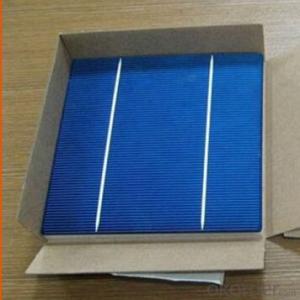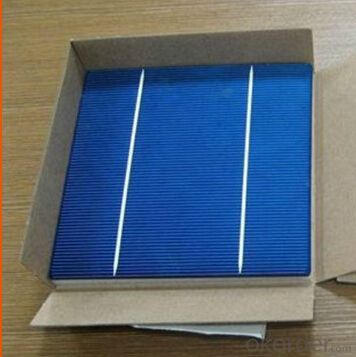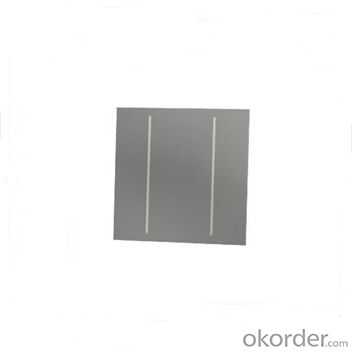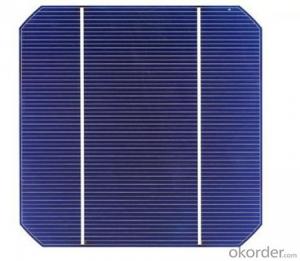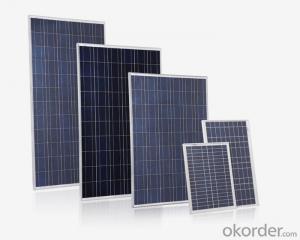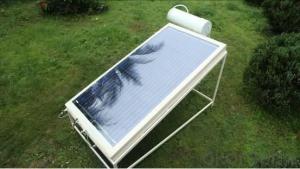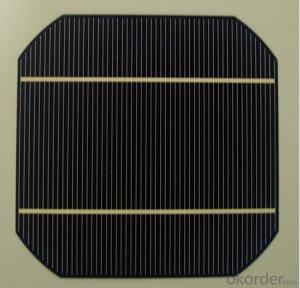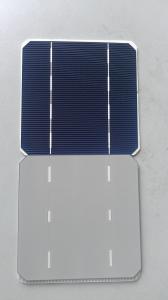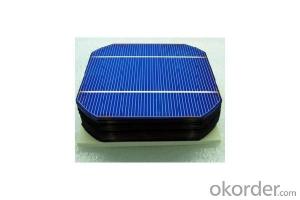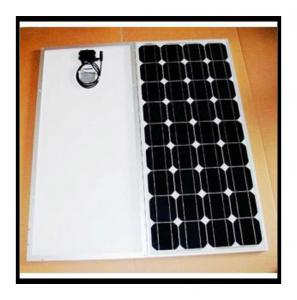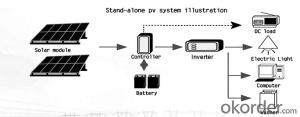Cheap Small Solar Cells - Monocrystalline Solar Cell 125mm×125mm±0.5mm
- Loading Port:
- Shanghai
- Payment Terms:
- TT OR LC
- Min Order Qty:
- 3000 PCS
- Supply Capability:
- 300000 PCS/month
OKorder Service Pledge
OKorder Financial Service
You Might Also Like
Solar Cells:
solar cells, when struck by photons of light from the sun, generates an electrical current which can then be used to power DC or AC electrical loads.
A solar cell is made of silicon. Computer chips are made of this same material. Basically, when light strikes the surface of a solar cell some of it is absorbed into the silicon. This light energy bumps the electrons loose and causes energy to flow
Solar cells is made by solar wafer, it has three categories of solar cell right now, monocrystalline polycrystalline and thin film,These cells are entirely based around the concept of PN junction, which is the critical part of solar module, it is the part that can convert the light energy into electricity, the thickness is from 180um to 200um, with even busbars to conduct electricity, textured cell can decrease diffuse reflection; they are often electrically connected and encapsulated as a module. Photovoltaic modules often have a sheet of glass on the front (sun up) side, allowing light to pass while protecting semiconductor wafers from abrasion and impact due to wind-driven debris, rain, hail, etc. Solar cells are also usually connected in series in modules, creating an additive voltage. Connecting cells in parallel will yield a higher current;With high quality and stable quality. Our Cells can greatly improve the performance of Solar Modules.
Features:
High efficiencies up to 16.4%
Proven long term mechanical stability of silicone
Make of highly purified poly silicone
Three bus bars for reduced series resistance and improved module and cell efficiency
Blue anti-reflecting coating ensures improved light absorption and increased efficiency
Acid texturization offers a uniform appearance and virtually invisible crystal structure
Excellent low light behavior for improved energy yield
Specifications
Dimension: | 125mm×125mm±0.5mm | |||||||||||
Diagonal: | 165mm±0.5mm | |||||||||||
Thickness(Si): | 200±20 μm | |||||||||||
Front(-) | Blue anti-reflecting coating (silicon nitride); | |||||||||||
1.6mmwide bus bars; | ||||||||||||
Distance between bus bars: 61mm . | ||||||||||||
Back(+) | Aluminum back surface field; | |||||||||||
2.5mm wide soldering pads; | ||||||||||||
Distance between bus bars :61mm . | ||||||||||||
Electrical Characteristics of mono solar cells 156x156 | ||||||||||||
Efficiency(%) | 19.4 | 19.2 | 19 | 18.8 | 18.6 | 18.4 | 18.2 | 18 | 17.8 | 17.6 | 17.4 | 17.2 |
Pmpp(W) | 2.97 | 2.94 | 2.91 | 2.88 | 2.85 | 2.82 | 2.79 | 2.76 | 2.73 | 2.7 | 2.67 | 2.62 |
Umpp(V) | 0.537 | 0.535 | 0.533 | 0.531 | 0.527 | 0.524 | 0.521 | 0.518 | 0.516 | 0.515 | 0.513 | 0.509 |
Impp(A) | 5.531 | 5.495 | 5.46 | 5.424 | 5.408 | 5.382 | 5.355 | 5.328 | 5.291 | 5.243 | 5.195 | 4.147 |
Uoc(V) | 0.637 | 0.637 | 0.636 | 0.635 | 0.633 | 0.63 | 0.629 | 0.629 | 0.628 | 0.626 | 0.626 | 0.625 |
Isc(A) | 5.888 | 5.876 | 5.862 | 5.848 | 5.839 | 5.826 | 5.809 | 5.791 | 5.779 | 5.756 | 5.293 | 5.144 |
Solar Cells Advantage:
1. High efficiency and High power.
2. Long-term electrical stability.
3. Lowest price and Fastest delivery.
4. Good quality and good service.
5.Bulk supply
6. Good Warranty
7.Big Sale
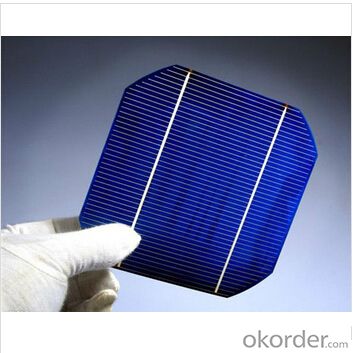
FAQ
We have organized several common questions for our clients,may help you sincerely:
1, What’s price per product ?
A: It’s depends on the quantity, delivery date and payment terms of the order. We can talk further about the detail price issue. Our products is high quality with lower price level.
2, How to make payment?
We accept T/T or L/C.
3, What is your lead time?
Generally 1-5 weeks depends on the order quantity and your specific requirements.
4, Can you do OEM for us?
Yes, we can.
5, How do you pack your products?
We have rich experience on how to pack the panels to make sure the safety on shipment when it arrives at the destination.
- Q: How do solar cells contribute to reducing greenhouse gas emissions?
- Solar cells contribute to reducing greenhouse gas emissions by generating electricity from sunlight, a renewable and clean source of energy. By harnessing solar power, solar cells eliminate the need for conventional fossil fuel-based electricity generation methods, such as burning coal or natural gas, which release large amounts of greenhouse gases into the atmosphere. Therefore, the widespread adoption of solar cells helps decrease our dependence on fossil fuels, mitigates climate change, and contributes to a more sustainable future.
- Q: What is the impact of hailstorms on solar cells?
- Hailstorms can have a significant impact on solar cells. The high-speed impact of hailstones can cause physical damage, such as cracks or fractures, to the surface of solar panels. This can result in reduced efficiency and output of the affected solar cells. Additionally, hailstorms can also damage the protective layers on solar panels, increasing the risk of moisture ingress and potential corrosion. Therefore, hailstorms pose a potential threat to the durability and performance of solar cells.
- Q: Doping and Diffusion Principle in Solar Cell Processing
- Doping in semiconductors refers to the incorporation of phosphorus or gallium in semiconductor silicon to obtain n-type or p-type semiconductor materials, thereby fabricating a wide variety of semiconductor devices.
- Q: What is the role of tracking systems in maximizing solar cell efficiency?
- Tracking systems play a crucial role in maximizing solar cell efficiency by continuously adjusting the position of solar panels to optimize their exposure to sunlight. This ensures that the panels are always facing the sun at the optimal angle, resulting in increased energy capture and higher overall efficiency.
- Q: Can solar cells be used to power remote data collection systems?
- Yes, solar cells can be used to power remote data collection systems. Solar cells convert sunlight into electricity, making them an ideal renewable energy source to power data collection systems in remote areas where access to traditional power sources may be limited or unavailable. The energy harnessed by solar cells can be stored in batteries for continuous power supply, ensuring reliable operation of remote data collection systems.
- Q: Can solar cells be used in water?
- Yes, solar cells can be used in water. However, it is important to note that the efficiency of solar cells decreases when submerged in water due to reduced sunlight penetration. Additionally, precautions must be taken to ensure the waterproofing and insulation of the solar cells to prevent any damage or electrical hazards.
- Q: Can solar cells be used for powering electric vehicle charging stations?
- Yes, solar cells can be used for powering electric vehicle charging stations. Solar panels can convert sunlight into electricity, which can then be used to charge electric vehicles. This renewable energy source is ideal for charging stations as it reduces reliance on traditional power grids and reduces carbon emissions.
- Q: How do solar cells perform in high-altitude locations?
- Solar cells perform well in high-altitude locations due to several factors. Firstly, at higher altitudes, there is less atmospheric pollution and dust, resulting in cleaner and clearer sunlight, which enhances the performance of solar cells. Additionally, the thinner atmosphere at high altitudes allows for less scattering and absorption of sunlight, enabling solar cells to receive a higher intensity of solar radiation. This combination of cleaner and more intense sunlight makes solar cells more efficient and productive in high-altitude locations.
- Q: Can solar cells be used in floating solar farms?
- Yes, solar cells can definitely be used in floating solar farms. Floating solar farms, also known as floating solar panels or floating photovoltaic (PV) systems, are an innovative approach to harness solar energy by placing solar panels on a body of water. These systems offer several advantages such as increased energy efficiency due to the cooling effect of water, reduced land requirements, and minimized evaporation from the water surface. Therefore, solar cells are a suitable and effective solution for generating renewable energy in floating solar farms.
- Q: Is a solar cell expensive to make?
- If you just want to make one solar cell for fun, it's not expensive.
Send your message to us
Cheap Small Solar Cells - Monocrystalline Solar Cell 125mm×125mm±0.5mm
- Loading Port:
- Shanghai
- Payment Terms:
- TT OR LC
- Min Order Qty:
- 3000 PCS
- Supply Capability:
- 300000 PCS/month
OKorder Service Pledge
OKorder Financial Service
Similar products
Hot products
Hot Searches
Related keywords
